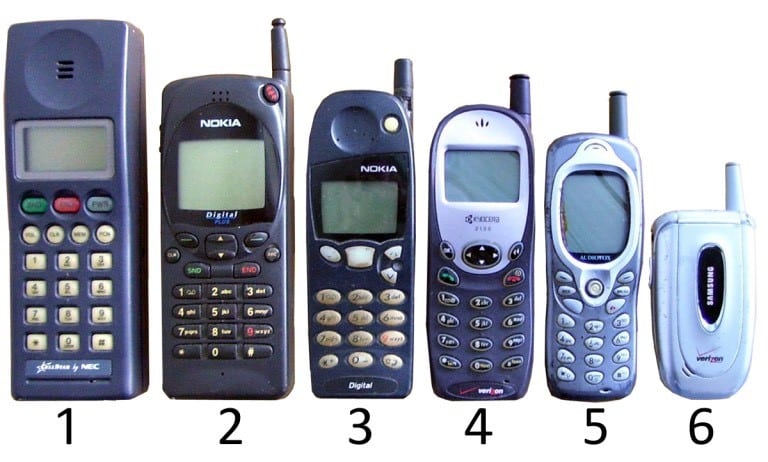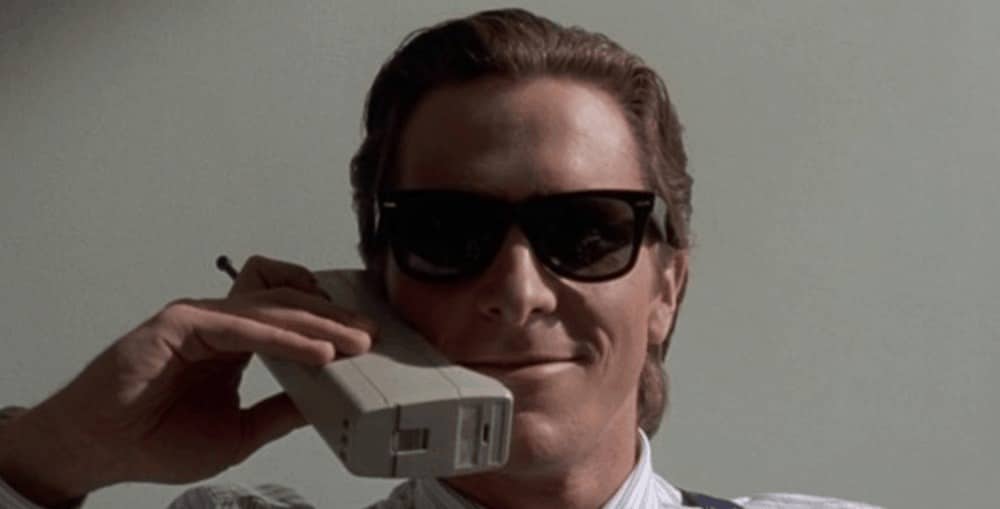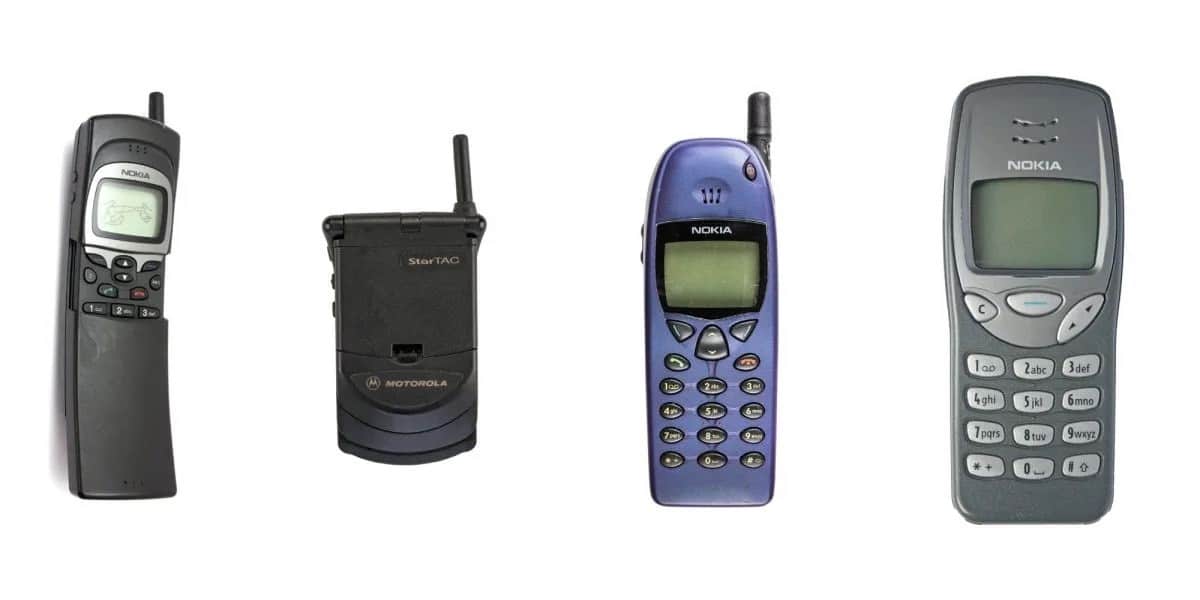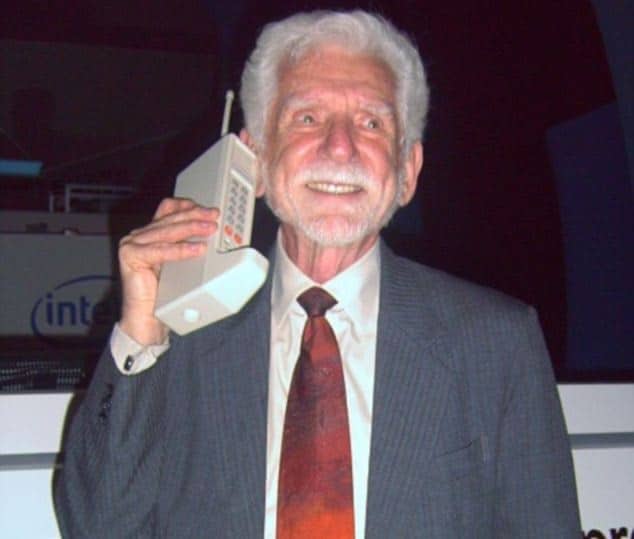Highlights
- Mobile phones in the ’90s were bulky and expensive, mainly used for voice communication only.
- The era marked the foundation of the mobile phone industry, leading to the modern-day telecommunication boom.
- Mobile phone technology has significantly advanced since the ’90s, giving rise to sleek and feature-rich smartphones.
Top Throwback Phones From the 90s
Best phones from the 1990s – A look back to the exciting mobile phone industry

Mobile phones in the 90s were nothing like the current sleek and powerful smartphones with large touch displays that we all use today. The change from the 90s mobile phones to now is not limited to design philosophy though.
In fact, the whole purpose of having a mobile phone has been through drastic changes in the past three decades.
In this blog, we are taking a walk through memory lane and looking at throwback mobile phones from the 90s era.

Mobile phones actually existed before the 1990s as well. However, they were primarily bulky and expensive devices used only for voice communication.
Moreover, the technology was inaccessible to the general public till the late 1980s and early 1990s.
The ’90s were essentially the foundational period for the mobile phone industry. It was the time when the stage for the mobile revolution was crafted and what followed was a boom of modern-day telecommunication.

Since then, mobile phone technology has only continued to advance and paved the way for more sophisticated and feature-rich devices of today.
Some of the popular phones from the 90s include the Motorola StarTAC. Introduced in 1996, StarTAC was one of the earliest flip phones and a fashion statement of its time.
Ericsson GH 337, known for its sleek design, was released in 1997 and was appreciated for its user-friendly interface.
The Nokia 8110, famously featured in the movie “The Matrix,” boasted a unique sliding cover design.
Before we explore more about the mobile phones from the 90s, let’s try to understand how mobile phones of that era were different from today’s smartphones.
The Evolution of Cell Phone ( History of Cell Phone)
How Were Mobiles Phones from the 90s Different from Today’s Smartphones?

So, what was different about mobile phones from the 90s?
How was the mobile phone technology different from what you and I are using today?
Let’s find out.
Following are points of difference between today’s smartphones and the mobile phone landscape of the 90s –
Mobile Phone Brands: In the 1990s, several companies were prominent in the mobile phone market. Nokia, Motorola, Ericsson (later Sony Ericsson), and Siemens were some of the leading players.
Nokia, in particular, gained popularity with its durable and user-friendly phones. Compared to this, the mobile phone industry today is brimming with international brands manufacturing devices to cater for a larger consumer base.

Size and Design – Mobile phones of the ’90s were large and heavy. They were commonly referred to as “brick phones” due to their size and shape. Today, the phone design philosophy is ruled by portability.
Antennas – Most mobile phones in the ’90s had external antennas. Users had to pull out manually to improve reception. Antennas seem like an alien concept with respect to today’s smartphones.
Networks – Analog cellular networks were prevalent during the early ’90s, but they gradually transitioned to digital networks like GSM (Global System for Mobile Communications) and CDMA (Code Division Multiple Access).
The digital networks that we use today allowed for improved call quality and better battery life.
Battery Life – The battery life of ’90s mobile phones was relatively short compared to today’s standards. Users had to charge their phones frequently.
Mobile Phone Features – The primary function of mobile phones in the ’90s was voice calls, though they did have basic text messaging capabilities. The functionality was limited compared to what all today’s smartphones have to offer.
Limited Coverage – The coverage of mobile networks was not as widespread as it is today. Rural areas in particular had no network coverage during those days.
Cost – Mobile phones in the ‘90s were quite expensive. It was, in fact, a luxury item for most of the general public. The cost of both the handset and the service plans largely became accessible to a significant portion of the population only in the 2010s.
Best Mobile Phones from The 90s

Speaking of mobile phones from the 90s, we have curated a list of the best mobile phones from the 90s.
These mobile phones from the 1990s left a lasting impact on the mobile industry and paved the way for the technological advancements that continue to shape our modern-day smartphones.
So, let’s get into it.
Motorola StarTAC
Introduced in 1996, the Motorola StarTAC was revolutionary as one of the earliest clamshell (flip) phones.
It set a trend for stylish, compact devices. The StarTAC was significantly smaller and more portable than its predecessors, featuring a monochromatic external display and an internal keypad.
It offered voice dialling and a phonebook. The phone’s foldable design made it a status symbol, and it became popular among professionals and celebrities. Its innovative form factor and functionality paved the way for future flip phones.
Ericsson GH 337
Introduced in 1997, the Ericsson GH 337 stood out for its sleek and compact design. The phone featured an eye-catching chrome finish and an external monochromatic display that showed incoming calls and messages.
It had a user-friendly interface and an extendable antenna for improved signal reception. The GH 337 was praised for its clear voice quality and ergonomic keypad layout.
While not as ubiquitous as some other models, it garnered a dedicated following for its aesthetics and functional simplicity.
Nokia 5110
Released in 1998, the Nokia 5110 was a game-changer with its customizable Xpress-On covers, allowing users to personalize their phones. It featured a clear monochromatic display and an intuitive menu system.
The phone was known for its reliability and extended battery life. The built-in antenna improved portability, and the phone also introduced the game “Snake II.” Its popularity extended globally, making it one of Nokia’s best-selling models of the ’90s.
Nokia 8110
Known as the “banana phone,” the Nokia 8110 gained fame after appearing in the movie “The Matrix” in 1999. It had a unique sliding cover design, which exposed the keypad when opened.
The phone featured a monochromatic display and allowed basic text messaging and call functions.
While not as feature-rich as other models, its appearance in the blockbuster movie “The Matrix” propelled it to pop culture stardom.
Its distinctive design and cult status make it a notable and memorable device from the ’90s.
Alcatel One Touch 511
Released in 1998, the Alcatel One Touch 511 was a budget-friendly mobile phone that became popular for its affordability and reliability. The candy-bar phone had a clear monochromatic display and an easy-to-navigate menu.
It offered essential calling and messaging features and also included some basic games for entertainment.
The Alcatel One Touch 511 found success in the mid-range market segment, appealing to users seeking a simple and functional mobile device.
Siemens S10
Launched in 1998, the Siemens S10 was a notable contender in the ’90s mobile phone market. It boasted a slim and modern design, making it stand out from its bulkier counterparts.
The phone featured a monochromatic display and had a user-friendly menu system. It offered basic calling and messaging functionalities along with a WAP browser for mobile internet access.
The Siemens S10 gained popularity for its compact form factor and technological capabilities.
Nokia 1011
Introduced in 1992, the Nokia 1011 holds a significant place in mobile phone history as Nokia’s first mass-produced GSM phone. As one of the pioneers in the digital mobile revolution, the Nokia 1011 marked a crucial shift from analogue to digital technology.
Sporting a sleek and ergonomic design, it featured a monochromatic LCD screen and a numeric keypad. The phone allowed users to send and receive text messages, a novel feature at the time.
Despite its basic functionalities, the Nokia 1011 represented a monumental leap in mobile communication and set the stage for Nokia’s dominance in the industry in the years to come.
Motorola Timeport
Introduced in the late 1990s, Timeport was a groundbreaking mobile phone that combined innovative features for its time. It was one of the first mobiles to integrate GSM capabilities with a built-in dual-band modem, enabling seamless data access and mobile internet connectivity.
The Timeport featured a compact and stylish flip-phone design, equipped with a monochromatic display and a user-friendly interface.
It offered basic calling and messaging functionalities alongside email and internet browsing capabilities.
This fusion of communication and data access made the Motorola Timeport a sought-after device, contributing to the evolution of mobile technology and shaping the future of smartphones.

Things You’ll Only Know If You Had A Mobile In The ’90s
FAQs
Q1. What was the first phone in the 90s?
Answer. The world’s first mass-produced phone that used the new GSM digital standard, the Nokia 1011 was ‘available in any colour, as long as it was black.
Q2. When was Motorola Dynatac 8000X released?
Answer. Known in the industry as “the brick” and visible in many scenes of the 1987 movie Wall Street, the Motorola Dynatac 800X was released in the 1980s. It was the first handheld mobile phone and loudly announced the beginning of a new era.
Q3. What were some common features of mobile phones in the 90s?
Answer. Mobile phones in the 90s primarily focused on voice calls and basic text messaging. They had monochromatic displays, external antennas, and physical keypads. Some models offered rudimentary games and limited organizer functions.
Q4. Which were the most popular mobile phone brands in the 90s?
Answer. Nokia, Motorola, Ericsson (later Sony Ericsson), and Siemens were among the most popular mobile phone brands in the 90s. Nokia, in particular, gained widespread recognition for its durable and user-friendly handsets.
Q5. How did the design of mobile phones in the 90s differ from today’s smartphones?
Answer. Mobile phones in the 90s were notably bulkier and heavier, often referred to as “brick phones.” They featured external antennas and smaller monochromatic displays, lacking the large touchscreens and sleek designs of modern smartphones.
Q6. Were mobile phones in the 90s affordable for everyone?
Answer. No, mobile phones in the 90s were relatively expensive, making them a luxury item for many people. Both the cost of the handset and the service plans were significant barriers to accessibility for a considerable portion of the population.
Q7. What was the significance of the Nokia 3310 in the 90s mobile phone market?
Answer. The Nokia 3310, launched in 2000 but with a lasting impact throughout the 90s, became an iconic mobile phone due to its legendary durability and exceptional battery life. It featured basic functions like voice calls and text messaging, as well as the popular game “Snake,” solidifying its position as one of the most beloved and recognizable phones of that era.
8) Top five throwback phones from the 90s.Details?
Ans) Mobile phones have come a long way, here’s a throwback to the best and most innovative phones of the 90s.
That phone you’re holding in your hand right now to read this article, is a ridiculously powerful super computer. If we threw a Samsung Galaxy S7 or even Apple’s original iPhone from 2008, into a time machine and sent it to the Johnson Space Center in 1965. We probably would never have heard the iconic, heart stopping phrase: “Houston, we’ve had a problem” from the Apollo 13 space crew (often misquoted as “Houston, we have a problem” because of the movie).
The processing power of the computers used for mankind’s first landing on the moon (Apollo 11) are laughable at today’s standard. The Apollo Guidance Computer enabled astronauts to enter simple commands in verbs and nouns to control their spacecraft. It ran approximately with 64Kbyte of memory and operated at 0.043 MHz. For comparison the S7 has 4GB of memory and a processing power of 2.3 Ghz.
We take a look at devices from the 90s, when smartphones started to gravitate towards more slim line designs, with affordable prices. Nostalgia, prepare for it.
Motorola StarTAC (1996)
Inspired by Captain Kirk and his crew on the Enterprise, the Motorola StarTAC saw great sales despite a massive price tag of £1400. Add inflation on top and it actually works out to be around £2400 today, brand new. Those who bought it loved the flip lid and it’s ergonomic design. Motorola reportedly sold about 60 million units of the StarTac.
Nokia 8110 (1996)
To most people this beauty is known as “the banana phone.” For millennials it’s the “Matrix phone.” Sadly you can’t actually go into the Matrix with the 8110 and learn Kung Fu. But you could carry it around for days as it was one of the lightest phones at the time weighing in at 145g. It was also the first Nokia device with a clear monochrome graphic LCD display.
Nokia 6110 (1997)
This ladies and gentleman is the first device to run the legendary Snake. It was from the 6110’s popularity, that Nokia decided to include Snake in the majority of their phones and future sequels of Snake. The 6110 improved on the Nokia 2110 with a smaller size and improved talk time. Another first; it was the first phone to use an ARM processor.
Siemens S10 (1998)
The S10 wowed the world as it was the first ever device with a colour screen. Capable of displaying red, green, blue and white. Unfortunately the amazement was short lived as consumers didn’t care about the innovation as Siemens would hope. The S10 is still worth a mention for the innovation and it inspired the creation of the popular sliding Siemens SL10.
Nokia 8210 (1999).
You weren’t cool unless you were holding Nokia’s slim line beauty at the time. It’s legacy lives on as the 8210 is now popular among drug dealers. We spoke to a dealer known as Sonny, who expressed his love for the 8210. “It’s small, peng (beautiful) and lasts for days. Best thing though, the Popo (police) can’t track it, bare apps on phones nowadays get you caught.” The 8210 does not have GPRS, NFC, WiFi or even Bluetooth. Making it harder for authorities to track down dealers.
9) What is the Evolution of the Cell Phone.Details?
Ans) The cellphone turns 40 this month, and it has come a long way from the enormous $3,995 brick that creator Martin Cooper first used walking along the streets of New York City in 1973 to call Joel Engel, the head of research at his rival company Bell Labs.
Let’s take a look back at the evolution of the omnipresent mobile phone.
1973 – The first cell phone
The phone Martin Cooper designed for Motorola weighed 2.5 pounds and had a battery life of 20 minutes.
1983 – Motorola DynaTAC 8000X
The Motorola DynaTAC 8000X was used by Gordon Gecko in the 1987 film Wall Street and was nicknamed ‘The Brick,’ for obvious reasons. Given its huge price tag (roughly $9,400 in 2013 dollars), it is not surprising that only Wall Street Masters of the Universe like Gecko could afford it.
1984 – The Nokia Mobira Talkman
The lunchbox-sized Nokia Mobira Talkman might have been a nightmare to carry around, but it had longer battery life than the sturdy ‘Brick.’
1995 – The Motorola StarTAC
The first flip phone, the Motorola StarTAC (seen here in Clueless), was becoming commonplace in the mid-’90s. Finally phones were approaching a reasonable size.
1996 – The Nokia 8110
The ‘banana’ phone, the Nokia 8110, was also Neo’s phone in The Matrix (1999) – and was the first example of the sliding form factor.
1998 – The Nokia 5110
Who didn’t play endless games of Snake on their Nokia 5110? A generation was introduced to cellphones and texting with this little creation.
2004 – Motorola Razr
The Motorola Razr was best known for being ultra-thin and for having a seven-hour battery life.
2007 – The iPhone
And then came the game changer – the Apple iPhone reshaped the mobile phone industry.
10) Phones from 90s to 2022 that changed the camera game for users.Details?
Ans) Kyocera VP-210: First phone to come with camera
This idea of a phone camera started with the Kyocera VP-210. Launched in 1999, it is the world’s first camera phone. The phone packed a 0.11MP sensor and it was capable of capturing up to 20 pictures.
Audiovox PM8920: Started the ‘megapixel concept’ in phones
Audiovox PM8920 was the first phone to feature a megapixel-resolution camera. It basically pioneered the idea of megapixels in phones. The phones came with a 1.3MP sensor with an LED flash and macro mode. The phone was launched back in 2004.
Nokia N90: Made video recording mainstream in phones
Nokia N90’s rotatable display design that made this phone transform into a camcorder made video recording easier for users and also conceptualized the idea of serious video recording feature on phones. It came with a 2MP Carl Ziess lens and was capable of recording video with audio.
Sony Ericsson cybershot K800i: Pioneered the high-res camera concept with modern features like auto-focus, image stabilisation and more
Sony Ericsson’s cyber shot series was among the most renowned camera phones back in the 1990s. There have been many cyber shot phones, but the K800i brought the high-res camera along with features like auto-focus, image stabilisation and more which are still relevant with modern smartphone cameras.
Nokia N95: The first 5MP camera phone
Launched in 2007, the dual side slider Nokia N95 can easily be considered as the most advanced camera phone of that time. The phone has everything from a high-resolution 5MP sensor, auto focus, video recording capabilities and it also came with a composite cable to view them on TV.
Samsung i8510, Samsung Pixon 12, Nokia N8 and Sony Ericsson S006: The megapixel race started with these phones
The Samsung i8510 came with an 8MP sensor, the Samsung Pixon 12 featured a 12MP sensor, Nokia N8 was also a 12MP phone and Sony Ericsson S006 was a 16MP phone. These phones actually brought the megapixel race to limelight which is still continuing.
Google Pixel: introduced Night Mode, still offers one of the best
The iconic camera phone list is incomplete without Google Pixel as the smartphone pioneered the AI and machine learning based image processing especially with Night mode and portrait mode. The night mode in Google Pixel phones are among the best in the market .
iPhone 13 series: Cinematic mode for ‘pro’ level videos
Apple has refined the camera experience on the iPhone over the years, so much so that it is perhaps the most consistent smartphone camera around. With the iPhone 13 series, Apple introduced Cinematic mode, which can record videos with a shallow depth of field, which really gives it a cinema-like feel. If you haven’t used it, then think of it as a portrait mode for videos, something that looks really cool.
Also Read: Nokia 2660 Flip Phone relaunched in two new colours shown by Retailers:Price, Specifications





















































